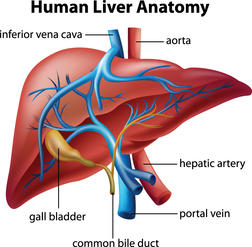Bile Duct Tumors and Cancer
Bile ducts are thin tubes that go from the liver to the small intestine. Their main job in the digestion process is to allow fluid, called bile, to travel from the liver and gallbladder into the small intestine, where it helps to digest the fats in food. 
About Bile Duct Cancer
Bile duct cancer, also known as cholangiocarcinoma, is a rare but aggressive form of cancer. Only about 8,000 people in the United States are diagnosed with bile duct cancer each year. The two main types of bile duct cancer are intrahepatic cancer, which forms in the bile ducts inside the liver, and extrahepatic, which forms in the bile ducts outside the liver.
Symptoms of Bile Duct Cancer
Since bile ducts and the liver are so closely connected, the symptoms of bile duct cancer can resemble those of other liver disease. Symptoms can include jaundice (yellowing of the skin or whites of the eyes), pain in the abdomen, itchy skin, dark urine, weight loss and fatigue.
Having colitis (a chronic bowel disease that causes inflammation in the digestive tract), cysts in the bile ducts or certain liver disease can increase the chances of developing bile duct cancer.
Multidisciplinary Treatment for Bile Duct Cancer
Although bile duct cancer is rare, our team at the Boston Pancreas, Liver and Biliary Center is well prepared to care for you. Our close collaboration with Dana-Farber Cancer Institute means that you will have a multidisciplinary group of world-renowned experts from both hospitals providing the best possible care for your cancer.
Different types of treatment are available for patients with bile duct cancer. Some are the standard treatments of care, like surgery, chemotherapy and radiation, while others are being tested in clinical trials.
Surgery for Bile Duct Cancer
The first course of action typically used to treat bile duct cancer is surgery. Surgeons will try to resect, or remove, part of the bile duct if the tumor is small and in the bile duct only.
If cancer is also found in the liver, one option for treatment is a partial hepatectomy in which part of the liver in where the cancer is found is removed.
Another surgical option is the Whipple procedure in which the head of the pancreas, the gallbladder, part of the stomach and small intestine and the bile duct are removed. After this procedure, enough of the pancreas is left to handle digestion.
Bile Duct Cancer - Chemotherapy and Radiation
Chemotherapy or radiation may be administered either before or after surgery. If surgeons have decided that operating on the bile duct is not possible, patients may receive one or both of these therapies instead. If patients do have surgery, some may still need to have chemotherapy or radiation to kill any remaining cancer cells.
Bile Duct Cancer Research and Clinical Trials Information
At academic medical centers like St. Elizabeth’s, researchers are always working to discover new treatments for many diseases, especially cancer. This is one of the many benefits of receiving your cancer care here at the Boston Liver, Pancreas and Biliary Center. Clinical trials can reveal new treatments that work even better than the standard treatment of care. We encourage you to speak with your physician to see if a clinical trial may benefit you.
Recent Research
Lunsford KE, Javle M, Heyne K, Shroff RT, Abdel-Wahab R, Gupta N, Mobley CM, Saharia A, Victor DW, Nguyen DT, Graviss EA, Kaseb AO, McFadden RS, Aloia TA, Conrad C, Li XC, Monsour HP, Gaber AO, Vauthey JN, Ghobrial RM; Methodist–MD Anderson Joint Cholangiocarcinoma Collaborative Committee (MMAJCCC). Liver transplantation for locally advanced intrahepatic cholangiocarcinoma treated with neoadjuvant therapy: a prospective case-series. Lancet Gastroenterol Hepatol. 2018 May;3(5):337-348. doi: 10.1016/S2468-1253(18)30045-1. Epub 2018 Mar 13. Erratum in: Lancet Gastroenterol Hepatol. 2018 Jun;3(6):e3. PMID: 29548617.
Omichi K, Cloyd JM, Yamashita S, Tzeng CD, Conrad C, Chun YS, Aloia TA, Vauthey JN. Neutrophil-to-lymphocyte ratio predicts prognosis after neoadjuvant chemotherapy and resection of intrahepatic cholangiocarcinoma. Surgery. 2017 Oct;162(4):752-765. doi: 10.1016/j.surg.2017.05.015. Epub 2017 Jul 5. PMID: 28688518.
Yamashita S, Koay EJ, Passot G, Shroff R, Raghav KP, Conrad C, Chun YS, Aloia TA, Tao R, Kaseb A, Javle M, Crane CH, Vauthey JN. Local therapy reduces the risk of liver failure and improves survival in patients with intrahepatic cholangiocarcinoma: A comprehensive analysis of 362 consecutive patients. Cancer. 2017 Apr 15;123(8):1354-1362. doi: 10.1002/cncr.30488. Epub 2016 Dec 16. PMID: 27984655; PMCID: PMC5384875.
Al-Shamsi HO, Anand D, Shroff RT, Jain A, Zuo M, Conrad C, Vauthey JN, Javle MM. BRCA-associated protein 1 mutant cholangiocarcinoma: an aggressive disease subtype. J Gastrointest Oncol. 2016 Aug;7(4):556-61. doi: 10.21037/jgo.2016.03.05. PMID: 27563445; PMCID: PMC4963380.
Ismael HN, Loyer E, Kaur H, Conrad C, Vauthey JN, Aloia T. Evaluating the Clinical Applicability of the European Staging System for Perihilar Cholangiocarcinoma. J Gastrointest Surg. 2016 Apr;20(4):741-7. doi: 10.1007/s11605-016-3075-5. Epub 2016 Jan 22. PMID: 26801328.
